Is the world as we see it?
Published:
In this blogpost, we ask a question ancient as philosophy itself: is the world as we see it? However we approach this question from the view of biology and neuroscience. We discuss three different perspectives on why the world is or is not as we see it: An evolutionary perspective, a resource optimization perspective, and the perspective of ambiguity of sensory information. With this question as guiding thread, this post introduces several major concepts of perception and neuroscience to a general audience.
This blogpost is a translation of a chapter I wrote for the book “Hitos y Mitos del Cerebro”, which is used in the homonymous first year undergraduate course at Universidad de la República, Uruguay. For the pdf of the original article in Spanish, click here.
Introduction
Approximately 2,400 years ago, Plato’s Republic was published in ancient Greece, containing his famous allegory of the cave (Figure 1). This allegory describes a group of people living inside a dark cave, where the only visible things are the shadows projected from the entrance of the cave onto one of its walls. Since they cannot see anything else, these people think that the world is made up of shadows and cannot conceive the world as we perceive it. This allegory makes us question the possibility that we might be in a situation similar to these people, and that our perception presents us with a distorted world. Thus, Plato raises the central question of this chapter: is the world as we see it? Despite its long history, philosophy has not abandoned this question, which, with its variants and other colorful examples like Descartes’ demon from 1641, or Putnam’s brains in vats has been one of the main guiding questions in the history of philosophy.

Although this question might seem simple, it can be interpreted and analyzed in many different ways. Therefore, to answer it, we must clarify what we mean by the words “see” and “world”. For example, if we take “see” as everything we can know with our senses and through science, we are asking whether there is a “world” that escapes us and that we cannot know by any method (or if we live in some sort of cave from which we cannot escape). This question would fall within the field of philosophy. On the other hand, if we take “see” as what we can perceive with our senses and “world” as the physical world, then we are faced with a question for physics. This question has a clear answer: the world is not as we see it. There are subatomic particles, dark matter, magnetic fields, and many other physical entities that escape our sensory organs.
In contrast to those other approaches, in this chapter, we will analyze the question from a biological and neuroscientific point of view. The version of the question we will study can then be posed as follows: is what we see with our senses an accurate image of the world at our physical scale?
What is seeing? Visual system general overview
Before we begin to analyze what biology says, it is necessary to reflect on what it is to see. Because our visual system provides us with an excellent ability to see so effortlessly, it difficult for us to appreciate the complexity of the task. To gain intuition about how complicated seeing is, let us consider a simple system: a robot with vision.
Suppose we have a small robot, and we want to make it see. The first thing that we need to do is give it a detector that receives light, or the equivalent of an eye. This could be simply a digital video camera. This camera receives the image of the scene and transforms it into a matrix of numbers, indicating the intensity of light at each point. This matrix of numbers constitutes a digital image, where each number represents a pixel (Figure 2).
But just taking pictures is not enough. Seeing involves extracting relevant information about the world from the pictures (e.g., what object is in front of me; how far away is it; what size is it, etc.). To do this, we must give the robot a computer with a program that extracts this information from these matrices of numbers. It is not difficult to realize how complex such a program needs to be to allow the robot to convert those number matrices into assessments like: “I have a medium-height marble table two meters in front of me.” For example, note that the numerical matrix (i.e., the raw image) can change radically if we modify the light source, move the robot slightly, change the background of the image, or rotate the table. The program faces the difficulty of giving the same result despite all those “trivial” changes. These difficulties can be seen in how difficult it is to develop fully self-driving cars despite the immense interest in this technology. Science and engineering have not yet solved this problem that our brain solves so effortlessly.
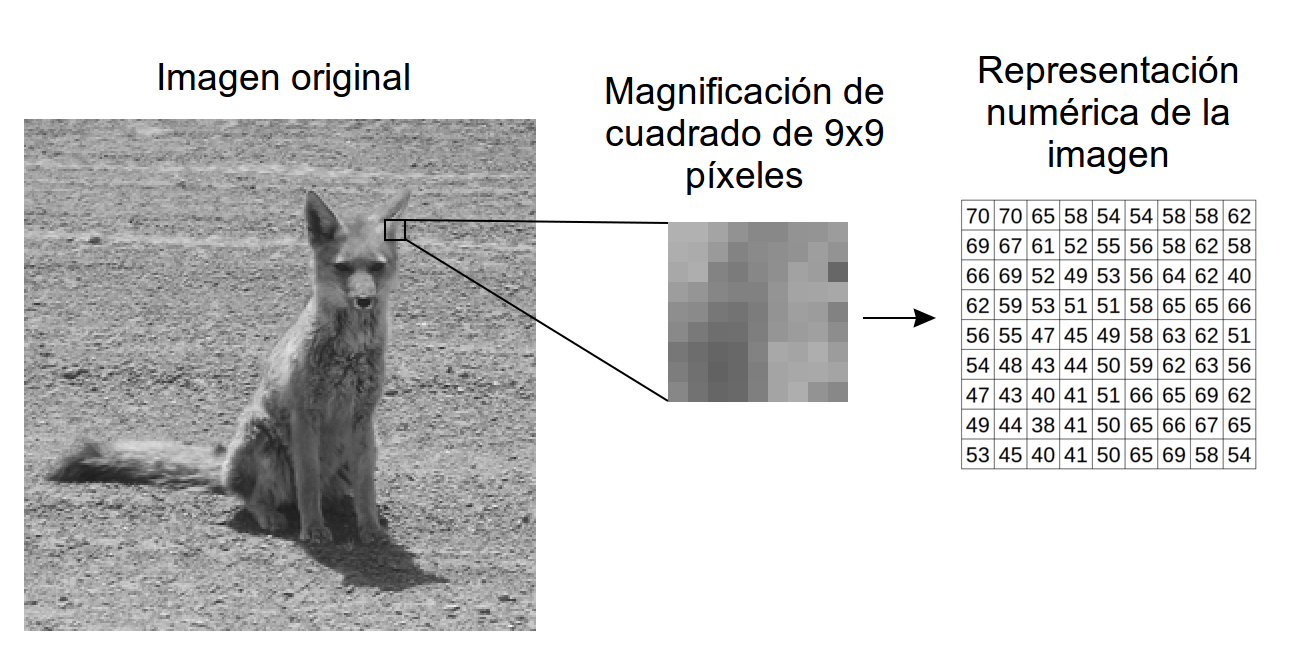
What is interesting about the robot example is that our visual system is not fundamentally different. Light enters our eyes and forms an image on the retina (located at the back of the eye). The retina is covered with light-sensitive cells called photoreceptors. Photoreceptors are active when they do not receive light and become inactive when illuminated. In this way, a photoreceptor with greater activation indicates a dark region of the image, and one with less activation indicates a lighter region, thus representing the image through neural activity. This system, by which the degree of illumination is sensed, can then be thought of as the one described earlier, with each photoreceptor acting like an individual pixel and its degree of activation as the numerical value in the matrix that is the image.
Then, just like the robot, the image must be processed to extract the relevant information. In our visual system, after initial processing in the retina, the optic nerve transmits visual information to the brain, where we have dozens of cortical areas dedicated to extracting information about the world. These areas are densely interconnected, and their functions are still not fully understood, but they carry out the processing that allows us to recognize a face, estimate a distance to throw a projectile, or choose the apple we like the most from the store. This processing occurs subconsciously, and we do not have access to it, but it is important to remember that “seeing” constitutes a complex processing and interpretation of the image by the brain.
Having established the complexity behind our ability to see, we are in a position to begin answering the question, that is, whether the processing our brain does of the image results in a faithful description of the world around us. To do this, we will analyze the question from three perspectives: 1) the evolutionary perspective; 2) the cost of processing information perspective, and 3) the ambiguity in the data perspective.
Evolutionary Perspective: The Visual System Did Not Evolve to See the World as It Is
Like the rest of the systems and biological processes that make up our organisms, the visual system evolved to contribute to our reproductive success. That is, evolution did not necessarily select for the visual system that best represents the environment, but rather the one that most favored survival and reproduction. An example that illustrates this point is our color vision, which went through an interesting path to reach its current state.
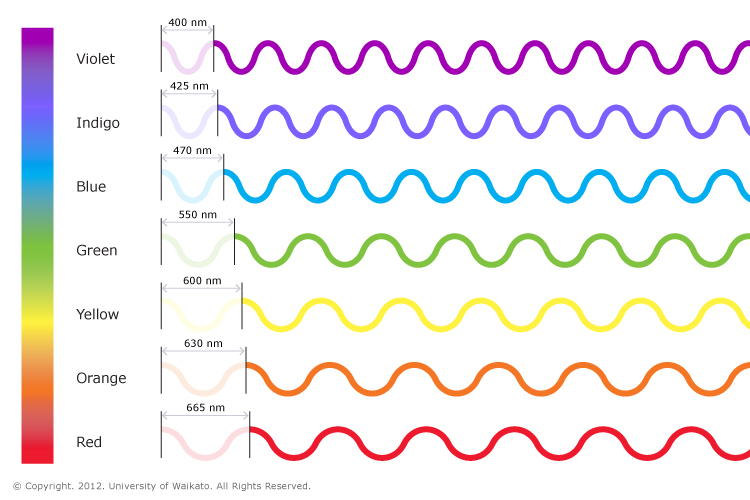
Light is an electromagnetic wave, and like other waves, it is characterized in part by its wavelength (Figure 3). Color vision is the ability to distinguish the wavelength of the light we perceive. How is this achieved? To begin with, a particular photoreceptor has a preference for certain wavelengths that can more easily modify its activation (Figure 4). But despite this preference, a single photoreceptor does not allow us to distinguish between different wavelengths, because its activation also depends on the intensity of the light. This means that a given photoreceptor activation can represent a high intensity of a non-preferred wavelength, or a low intensity of a preferred wavelength. On the other hand, two photoreceptors with different wavelength preferences do allow us to discriminate between wavelengths, letting us separate the contribution of light intensity and wavelength. Having more photoreceptors with different preferences allows an organism to better discriminate wavelengths, improving color vision.
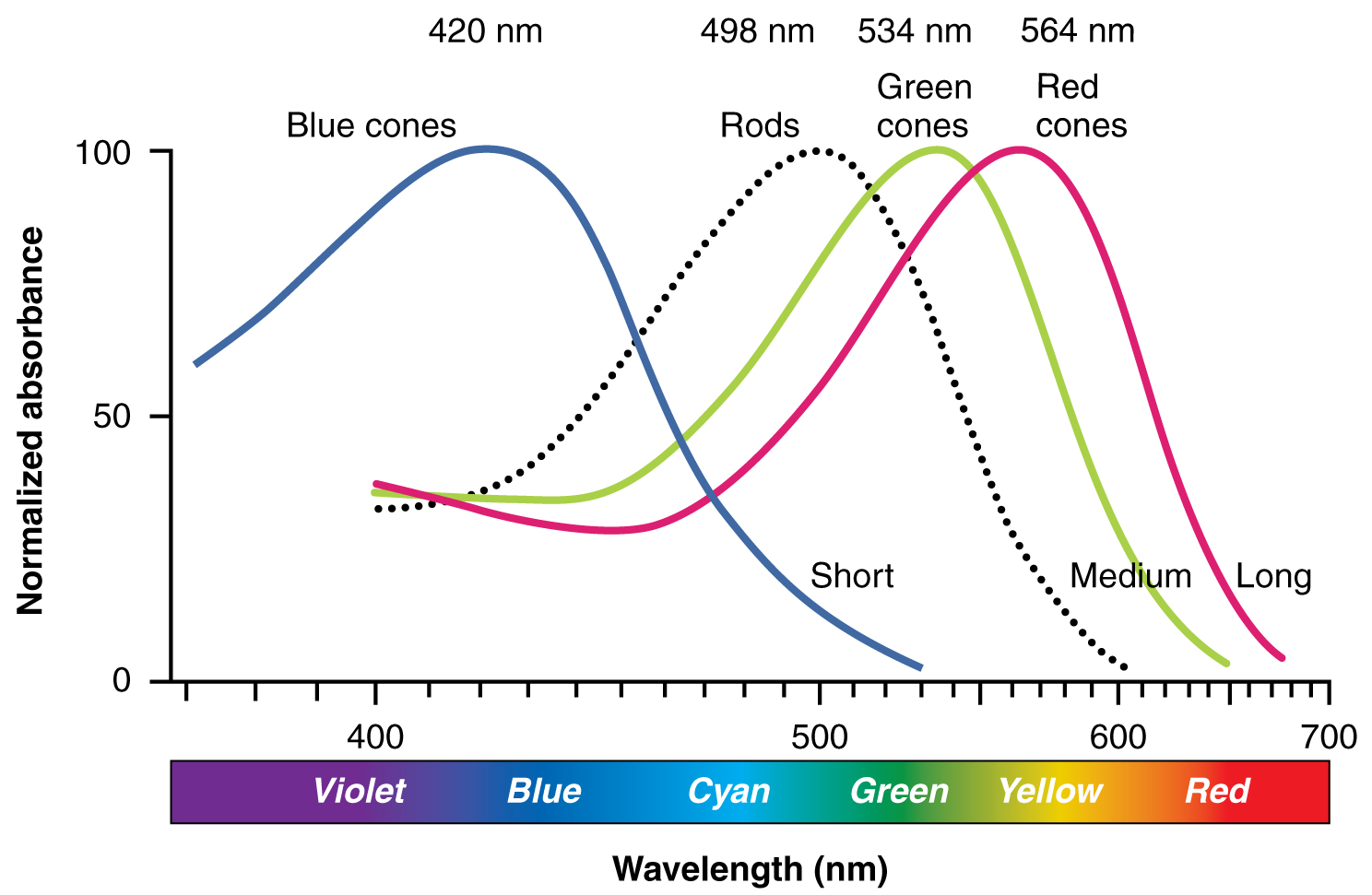
At one point in evolution, the subphylum of vertebrates came to have four different types of color photoreceptors. But then at another point in our evolution, mammals lost two of these photoreceptors (this was when we were nocturnal, and color vision was not as important for us), leaving them with only (or dichromatic vision). At a later point, however, primates acquired a new photoreceptor, bringing our total to three (or trichromatic color vision). This photoreceptor falls in the middle of our visible color spectrum, and makes it easier to discriminate green from other colors. The main hypothesis about what led this photoreceptor to be selected is that it was particularly favorable for better perceiving vegetation, for example, the fruits that were part of our diet against the green background of trees.
These two evolutionary events, the loss and re-gain of photoreceptors, show how evolution can select for improvements in sensory systems representation of the world, but that it can also lead to its deterioration. In this way, evolution has led us to currently perceive fewer colors than many species of birds that still maintain the four original vertebrate photoreceptors.
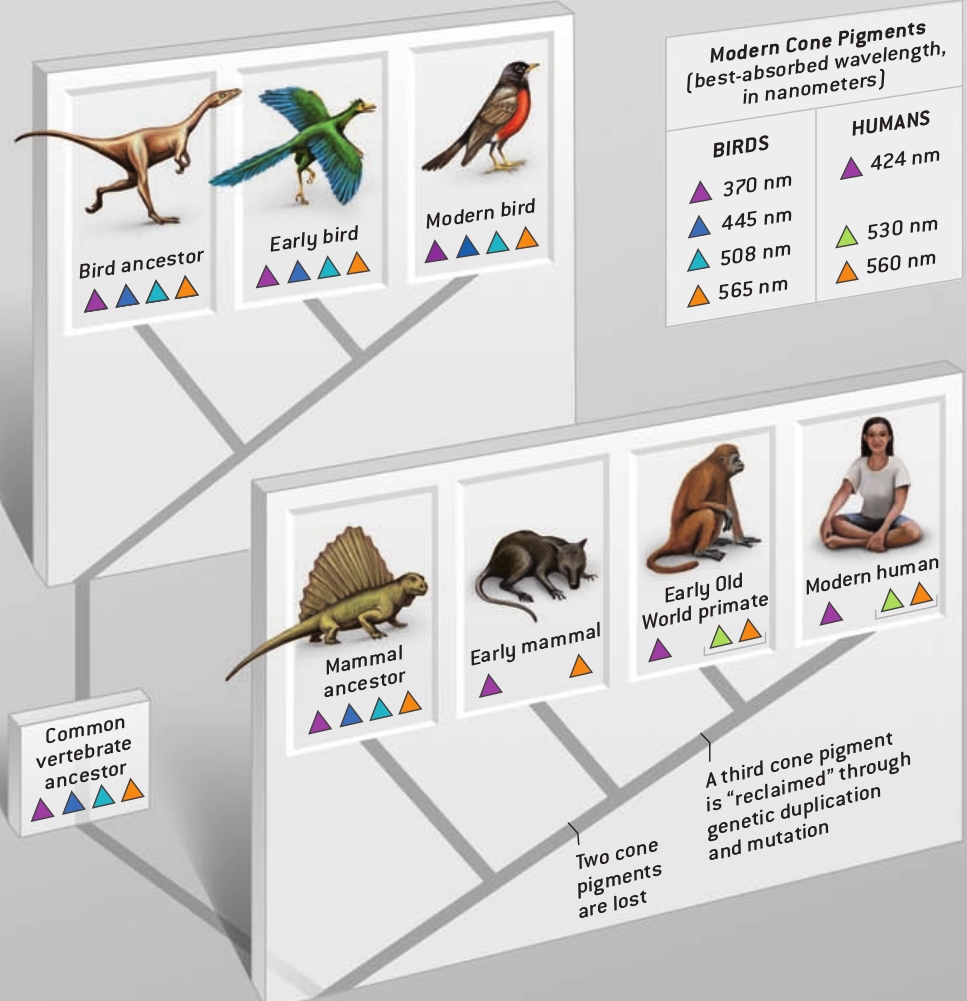
Another interesting example of the relationship between evolution and perception is the study of the frog’s visual system presented in the article “What the Frog’s Eye Tells the Frog’s Brain” by Lettvin et al., published in 1959. The experiment carried out in this article involves showing visual stimuli to a frog while recording the activity of the fibers of its optic nerve (which take the information from the eye to the brain) to determine what information about the scene these fibers transmit to the brain. One interesting thing about this article is that the authors discuss the results in the context of the natural behavior of the organism, which uses vision to hunt and escape predators. For example, the frog’s visual behavior has the peculiarity that it seems not to perceive the static elements of the world around it (e.g., food does not catch its attention if it does not move, see video). Moreover, its predatory behavior is mainly guided by the movement and size of visual objects: it will try to capture any small object that moves like an insect, even if it looks very different from an insect to us.
The authors discuss that this behavior fits very well with their findings on fiber activation. They describe four types of fibers in the optic nerve, each reporting about very specific visual patterns in the environment. For example, one of the types of fibers described by the authors is activated when a small shadow stops at a specific point in the visual field and moves intermittently. This type of fiber seems to correspond to the behavior of the frog described above, responding to the movement of small objects that move like insects. Therefore, the brain receives highly pre-processed information where a large part of the visual world detail is discarded, which may help explain why the frog’s visual behavior is so limited. The frog will then be able to detect this type of visual event, but not others for which it does not have fibers.
But, although the frog’s perception may seem limited to us, what is important is that it allows it to generate the necessary behaviors to survive and reproduce. For example, concerning the fiber described earlier, the authors ask: “can one describe a better system for detecting an accessible insect?” So, although the frog’s visual world is limited (for it is composed of some simple patterns like moving dots), it is sufficient for its ecological needs. Although it is easy to fool a frog in the laboratory with something that looks like an insect, the relevant question is: how many objects that are not insects have that size and move like them in its natural environment?
It is possible to notice a similarity between the frog case and the allegory of the cave, and although our visual system is much more complex, it is natural to ask now: to what extent do we suffer from limitations as great as those of the frog? In a certain way, our visual system carries out a similar process: the visual stimulus is already processed even in the retina, and in each visual area of the cerebral cortex, specific stimulus patterns are extracted and passed on to higher areas, and those were selected because of their contribution to our reproductive success. In this process, information about the world is also lost. For example, if we look at two different images of white noise (the static present in old televisions, Figure 6), these images are very different considered pixel by pixel, but they look identical to our visual system, which discards a lot of this information.
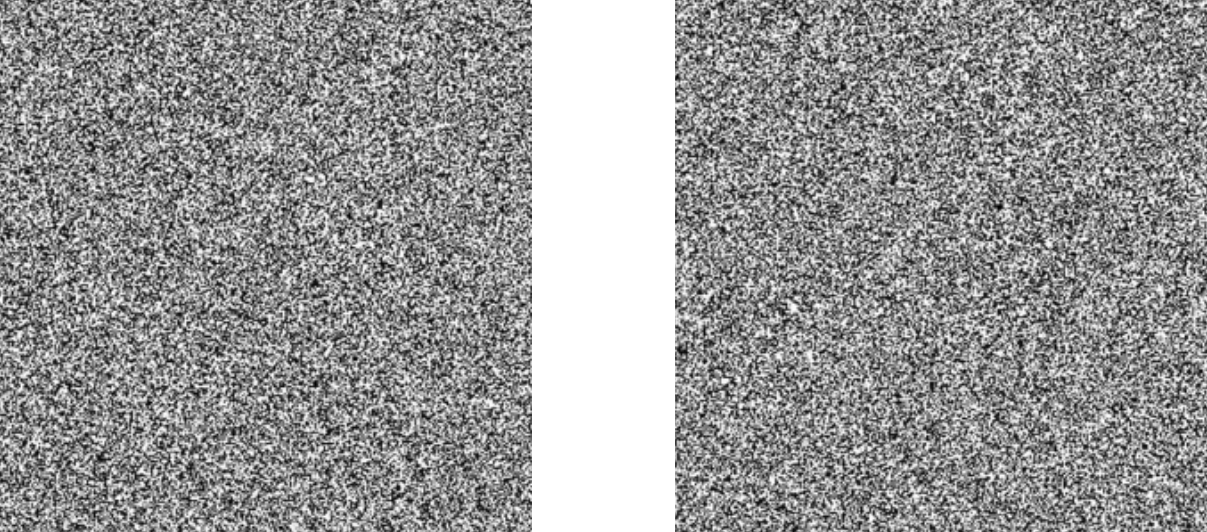
However, there are reasons to think that our visual system is not as affected as that of the frog. For example, the patterns detected in the early stages of our visual system (point-like structures in the retina; stripe-like structures in the primary visual cortex) are the same as those reached by mathematical tools that seek the best method of representing images. This suggests that perhaps we are capturing a large part of the information available in images. This observation also aligns with the argument that flexible goals and behavior such as that in higher mammals requires faithful representation of the world (e.g. see a technical analysis here). Thus, it could be expected that evolution has led us to see the world approximately as it is.
In summary, our visual system has been shaped by evolution to perceive those aspects that are important for our survival. However, our complex and adaptable behavior would seem to require the ability to faithfully perceive our environment, and some computational studies support this reasoning. Although there are aspects of the world that we do not perceive, the evolutionary perspective leaves open the possibility that we perceive the world accurately.
Perspective on the Cost of Representation: Representing the World Faithfully Is Expensive
Our brain is finite and has limited resources. Capturing and processing visual stimuli is costly, so our ability to perceive the world faithfully is also limited. However, evolution tends to lead to the efficient use of resources, and it happens that our visual system manages them in very efficient ways, allowing us to perceive correctly what is relevant to us. An important and illustrative aspect of resource use by our visual system is the separation between central and peripheral vision, which we describe below.
It is evident that vision plays a fundamental role in our cognition, which can be expressed by saying that we are a “visual animal.” In line with this, the brain dedicates a significant amount of resources to visual processing. But these resources are not distributed evenly to process the entire visual field; instead, their distribution marks a very strong distinction between two components of vision: central vision (corresponding to the part of the retina called fovea) and peripheral vision. These components are evident to us through introspection: while we perceive very clearly the part of the visual scene on which we focus our gaze, what falls in our peripheral vision is much less clear. An obvious example of this is that it is impossible for us to perform some tasks (like reading) with peripheral vision.
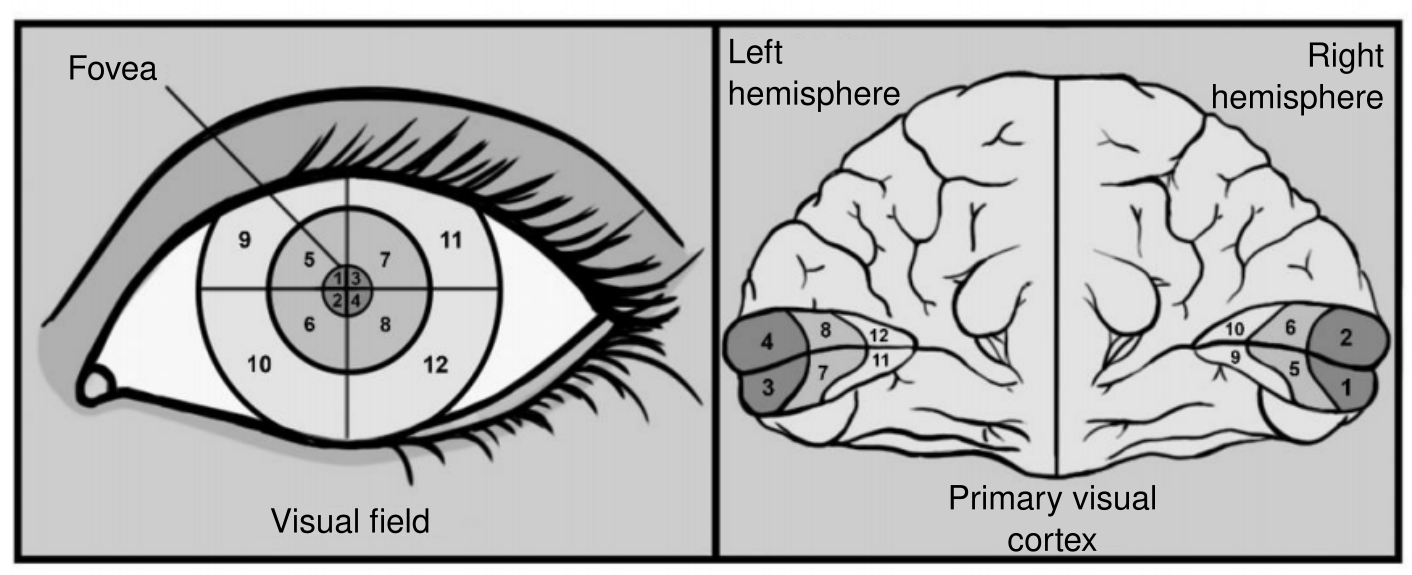
This division between central and peripheral vision is so natural to us that we don’t usually question it, but why do we see with little clarity in the periphery?; would it be possible to have the high resolution of central vision across the entire visual field? A key to understanding this is that although our central vision occupies a small fraction of the visual field (we can roughly define it as the visual area covered by our closed fist with an extended arm; Figure 7), it uses approximately half of the resources of our visual system. Thus, although peripheral vision occupies the majority of the visual field, it uses only the other half of the cortical resources. If we extrapolate the relationship between visual field and cortical area from central vision, processing our entire visual field with the sharpness of central vision would require a much larger brain than we have, which seems biologically impossible.
But even though we clearly see only a small part of the visual field, we use an important tool to make the most of the resources available: eye movements. We are constantly moving our eyes (and head) to capture the important elements of the environment with high precision. This scanning of the scene is something we know how to do so well that it feels natural and simple, and we don’t notice our constant eye movements. But our eyes are always subconsciously choosing for the most relevant aspects of the scenes to scan, allowing us to obtain large amounts of information with limited resources. With this efficient allocation of resources, we manage to attain a feeling of a detailed perception. But despite the efficiency of the system, we often overestimate our perception, as the following examples illustrate.
The phenomenon called change blindness is demonstrated experimentally by flashing in an alternating fashion two identical images that differ in some specific element (see YouTube example). The experiment consists of the participant identifying what the differences between the images are. What is interesting about the phenomenon is that even large differences between the images are difficult to identify. This result contrasts with our subjective impression: although we believe we perceive the image clearly, the reality is that it is difficult for us to remember even its most conspicuous elements.
Another example is inattentional blindness. This phenomenon consists of certain elements of images to which we are not paying attention going unnoticed, even though they are very visible. An iconic example (see here before you continue reading) consists of a video showing a group of people passing a basketball, and the task is to count how many passes are made. At the end of the video, it is revealed that a curious animal made an undisguised appearance that goes unnoticed to the viewer concentrated on counting the passes.
Another example, striking because of the participants expertise, is an experiment in which radiologists were asked to make a diagnosis on some tomography plates in which a visible image of a gorilla had been included (Figure 8). Although the radiologists examined the image closely, and almost all laid their eyes on the gorilla (as measured by the eye-tracking technique), when asked at the end of the experiment, most had not noticed the hidden ape. This last example also shows that it is not enough to have something in central vision to process it correctly. The allocation of resources in the visual system does not only occur in eye movements but also at the level of information processing, prioritizing one processing “pathway” over another.
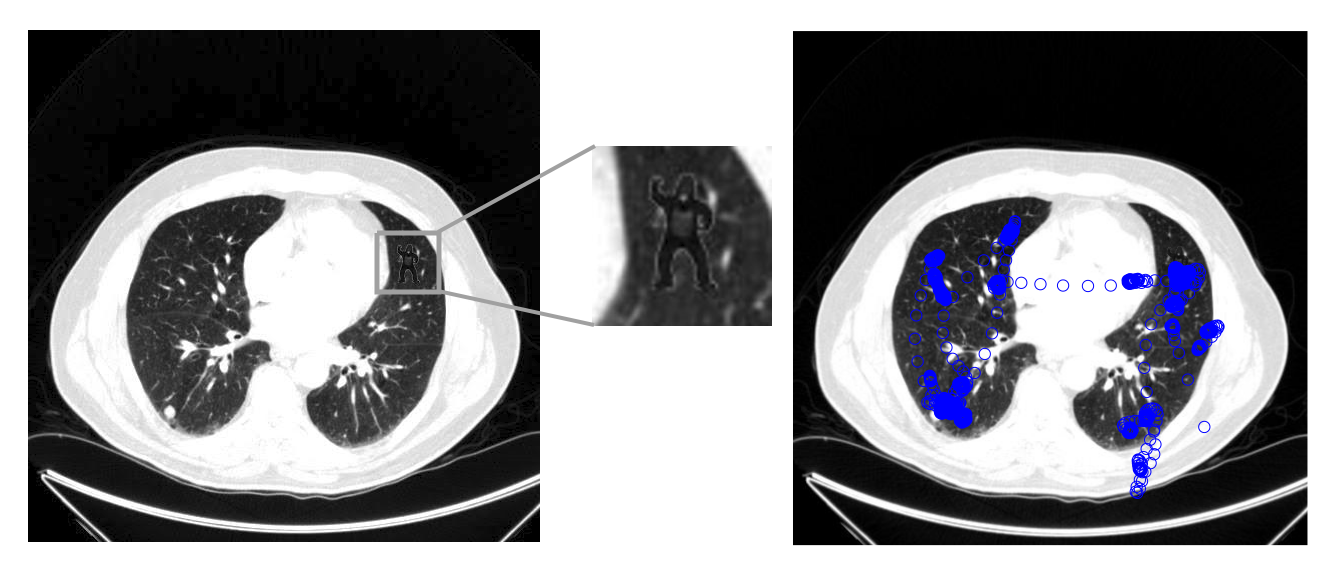
These examples illustrate how costly it is to process visual stimuli and how, at a given moment, we perceive only a small part of the scene with clarity. But is this something new? Before starting this section, any of us already knew that there are elements of the scene that we cannot perceive at a given moment, for example, what is behind us. Although it is interesting how our “real” or “objective” perception seems worse than we believe, this new discovery does not seem to close the issue since, from the beginning, we know that our visual system has limitations.
Moreover, these limitations do not imply that we cannot perceive well the specific elements of the world on which we focus our attention, just as not having eyes on the back of our heads does not mean we cannot turn around to see what is behind us. And although the examples discussed are striking, it is important to note that the real world is very different from the experimental manipulations that show these effects (e.g., in the real world, objects do not suddenly disappear as in change blindness experiments). From this, the next natural question is: the part of the scene on which we focus our attention and which we observe closely, is it as we see it?
Perspective on the Ambiguity of the Data: Seeing Requires “Interpreting” the World
The last aspect that we will consider is a fundamental aspect of the computational tasks of vision: visual stimuli are ambiguous, so we must interpret them to obtain information about the world. This stems in part from the fact that our visual input is two-dimensional (the plane of our retina, like the two dimensions of a photograph), while the external world has three spatial dimensions. Our visual system is very good at making (subconscious) interpretations of visual stimuli, making it difficult for us to see how they can be ambiguous, but nonetheless these necessary interpretations occur at various stages of visual processing.
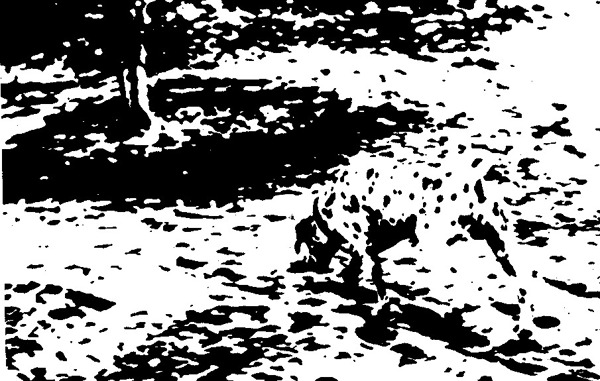
For example, one of the first steps in visual processing is to group the pixels into segments or surfaces (a process we call image segmentation”). This involves using some criterion to determine when two regions of the image belong to the same surface. But this is not easy. We can think of some simple rules to group image sections together (e.g., group pixels that have similar color and are close), but these simple rules will quickly fail in many real world cases. Our brain manages to group the elements of the images using complex rules that we still do not fully understand. For example, Figure 9 shows a classic scene with black spots spread across an image with very coarse information. But despite the chaotic appearance of the image, our brain manages to group the dots together into surfaces, group these into objects, and finally into a scene. Looking at how chaotic the image is, it is difficult to understand what evidence our brain uses to interpret that chaos of pixels. But beyond the details of processing, what matters here is that our brain is having to interpret many aspects of the image (such as what areas of the image are from the same surface), and that in general many interpretations are possible and our brain must choose one. The next example illustrates how this ambiguity in possible interpretations can lead to illusions.
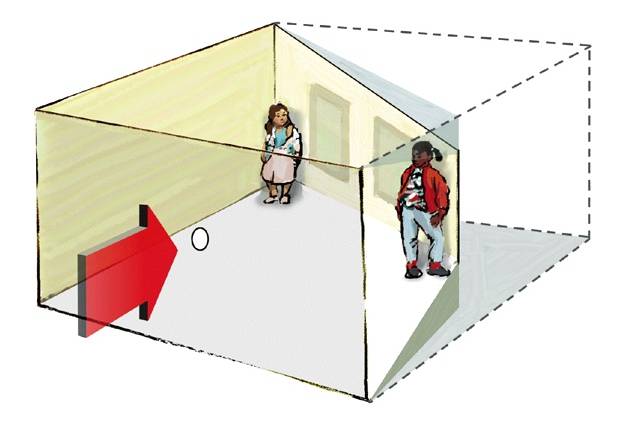
The Ames room is a classic illusion in which we generate a misinterpretation of a scene. This is a room with a particular shape: it is not rectangular, and both its walls and ceiling and floor are sloped and not parallel (Figure 10). To create the illusion, one of its walls has a carefully placed hole through which we can look and perceive a normal rectangular room (with parallel walls, ceiling, and floor). When we look through the hole, our perception is wrong, as we believe we see a normal room when, in fact, we have a distorted room in front of us. Moreover, if there are people in the room, depending on their position, we will perceive them as giants or as tiny (see a video here). The important thing to note here is that the visual stimulus in this case (and in all others) is ambiguous. It is compatible with both a rectangular room (as we mistakenly perceive) and the actual scene of the irregular room (since this is, in fact, what generates the image). In fact, the visual stimulus is compatible with infinite possible scenes. For example, it could be a giant room with giant people, a small room with small people, or it could have many different shapes with people of various sizes. The image is compatible with all these alternatives because all of them could generate the same pattern of light in our retinas, and interpreting the image involves choosing one of these alternatives.
This example show that our visual system makes interpretations of visual stimuli to perceive the scene around us, and that these interpretations can be wrong. But how does our brain arrive at these specific interpretations? Although this question is still an area of research, neuroscience can give us some answers. First, it is important to clarify that to investigate this, we normally study simplified stimuli that aim to understand the processing of a very specific type of information. Some examples could be how we use color to segment images or how we use visual textures to estimate distances. Despite the gap between these simplified experiments and our “natural” perception, they allow us to draw two relevant conclusions to our question: 1) the visual system uses a set of “rules” that allow us to construct the interpretation of the image, and 2) these rules are not arbitrary but are based on the structure of the world we inhabit.
In the process of choosing which of the possible scenes is the one that generates the image, the brain imposes restrictions (or rules) on the interpretation that helps select some possibilities and discard others. These rules mark how to interpret certain elements of the image and are applied at several levels and in parallel. For example, a phenomenon observed with simple stimuli is that our vision groups the elements of the image that are aligned in the direction of their orientation, that is, they are are collinear (Figure 11). On the contrary, elements that are aligned in the direction perpendicular to their orientation do not tend to be grouped. Then, using this rule to interpret natural images, our visual system can choose the interpretation of the scene that groups the elements that are collinear and discard other interpretations.
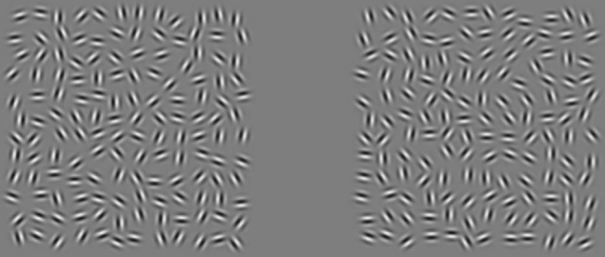
Another rule that the visual system uses is that it tends to assume that the light source comes from above. A common ambiguity is that the same image can be generated by a concave surface illuminated from above and by a convex surface illuminated from below, and vice versa. This ambiguity and our brains preference for light from above is why when seeing an image of a crater upside down, it looks like a hill (Figure 12). In the face of this type of ambiguity, our visual system will tend to choose the scene where the light comes from above and then interpret whether the surface is concave or convex according to this criterion. Thus, by applying a large number of rules, the visual system can choose one interpretation over another at different levels until reaching a global interpretation of the image we receive, which will be our perception. But where do these rules come from?; how do we know if they are good for perceiving the world?

Theoretical neuroscience research suggests that these rules we use to interpret images are based on the regularities of the world around us. Our world has a marked structure that gives rise to many regularities, that is, patterns that repeat in images and have predictable relationships with the world. For example, our visual environment is mostly composed of solid objects. Due to the laws of physics, objects generate continuous contours in images, consisting of collinear edges. This could explain the rule of grouping collinear elements as a reasonable consequence of the world’s structure: objects in the world tend to generate collinear elements, and it would be correct to group them to form a more global structure.
Similarly, it is easy to notice that in their vast majority, light sources in our natural environment come from above, so it makes sense to use a rule that chooses scene interpretations with this characteristic. Thus, the rules used by our visual system would be associated with the structure of the world around us and would help choose the image interpretations that best match it.
But, if these rules are derived from the world’s structure to represent it correctly, why do we perceive the Ames room and other illusions incorrectly? The answer is that they are atypical stimuli that violate the normal structure of the world. The image of the Ames room is generated by a specific perspective on a room with a very specific irregular shape, but this is a configuration that is unlikely to occur in the real world. It is much more likely that an image of that type is generated by a rectangular room with its parallel walls, ceiling, and floor. Although these illusions show the brain’s interpretations at work, they occur because of the use of contrived stimuli that are unlikely to be found in the real world.
In conclusion, images are fundamentally ambiguous, and a given image is compatible with infinite possible scenes, so perceiving involves a process of interpretation. But this process is not arbitrary, as it responds to rules that fit well with the world’s structure, ensuring that our interpretations are generally good.
So, What Is the Answer to Our Question?
We have seen three neurobiological reasons why the world might not be as we see it: 1) our visual system did not evolve to allow us to see the world as it is, but to guide useful actions; 2) representing the world as it is is very expensive, and 3) the stimuli we receive are ambiguous and require significant interpretation on our part. In all three cases, we saw examples that might suggest that the world is not as we see it. But we also discussed reasons why these limitations are not determinative: 1) we have very complex behavior that may require a faithful perception of the world (and available computational research seems to say that at least our basic neural processing is good); 2) we allocate our processing resources very well, and although a significant part of the world escapes us (which is inevitable), we build a decent image of it that we are attending to, and 3) our interpretations use rules that are based on the structure of the world around us, giving them a solid foundation.
Ultimately, the answer to whether the world is as we see it will depend on the precise definition of that question and the standards we have for what constitutes “seeing the world as it is.” And if it is disappointing not to have a concrete answer at the end of the chapter, perhaps it helps to remember that, despite its simple appearance, this question has sparked (and continues to spark) discussion throughout a significant part of the history of ideas.
To conclude, it is worth highlighting that although we marked a distinction between the philosophical question and the neuroscientific or cognitive one at the beginning of the chapter, philosophy is an integral part of cognitive sciences and neuroscience. Many of the questions studied by the latter are based on concepts that, when deeply examined, lead to analyses and discussions that currently belong to philosophy. Even though we did not explicitly highlight it, many points we took for granted in this chapter align with one or another philosophical perspective and can be harshly criticized from other philosophical perspectives (e.g., it is debatable whether the visual stimuli we receive are truly ambiguous, or whether our visual system constructs a 3D model of the world around us). Perhaps a good way to close the chapter is by revisiting Daniel Dennett (an important philosopher of science), who eloquently expresses this idea: “There is no such thing as science free of philosophy, there is only science whose philosophical baggage is carried on board without examination.”
